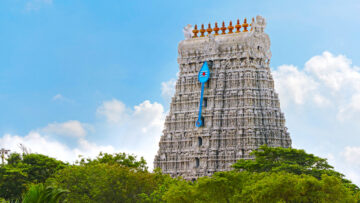The Tattvabodha (Gurubhaktananda 2017) talks about the sharira tryam (namely, the sthula sharira, the sukshma sharira and the karana sharira) and shows that these shariras are different from the Supreme Brahman. While these terms are informally understood, one often wonders what are the actual differences, especially when these shariras are related to karma and samsara. In this brief note, we explain the role of the shariras in a formal way. This formalism is orthogonal and simpler than the presentation in (Krishnan 2023). We first provide a summary of these terms and their roles in an informal way.
We know the sthula sharira (the gross body) consists of arms, legs, various organs etc. The first discussion of the sukshma sharira (the subtle body) is in Samkhya, where it is explained as a limited form of purusha. Vedanta (especially the Brihadaranyaka Upanishad (Radhakrishnan 2016)) makes it clear that the sukshma sharira is also composed of the five basic elements. Thus Vedanta and Samkhya differ in their philosophies about the sukshma sharira. Unlike the gross body, which is tangible and perceptible, the subtle body is not visible to others; hence the term subtle body. That is, one can see other beings’ physical bodies, but not the inner workings of their bodies. For instance, one cannot read other people’s minds. Hence the term sukshma sharira, which can also be translated as imperceptible body. But this does not imply that the sukshma sharira corresponds to the mind (Shastri). The sukshma sharira needs a physical body to be effective. Hence it searches for another body after the current body dies. The sukshma sharira is where one’s accumulated karmas are stored. This is consistent with the theory of re-birth and samsara. If the accumulated karmas were stored only with the sthula sharira, the death of the body will result in the death of the karmas. Thus the sthuhla sharira is useful to explain samsara. The past karmas start acting as soon as a new body is acquired. This is why even newborns can suffer.
The concept of karana sharira does not exist in Samkhya. It is mainly a Vedantic concept. The karana sharira, meaning the causal body, is the root cause for sentient beings to exist. Once the sentient beings come into existence, the karana sharira has no role. The motivation for the karana sharira comes from the theory of pralaya (the dissolution of the universe). It is used to answer the question “What happens when the universe dissolves?”. That is, “What happens to all the bodies that were in existence?” It becomes a seed from which the next iteration of creation starts. Just like after death the sukshma sharira is looking for a sthula sharira, at pralaya, the sukshma sharira becomes unmanifest and “merges” into the karana sharira. It is only at shristi (time of creation) that the karana sharira evolves to the sukshma sharira and then the sthula sharira. Thus the karana sharira has the essence of all the sukshma shariras in it. But the relations between the various shariras associated with a living entity is not clear and has to be derived explicitly. That is the reason we develop a formalisation that can help understand the difference between the different shariras.
Let b1, b2, b3 and b4 be different bodies (entities). Let b1 and b2 exist at the same time (say t1) while b3 and b4 exist at the same time (say t2) where t1 is not equal to t2. This can be represented by the function time. For example, time(b1) is t1 and time(b2) is t2.
Similarly, let functions sthula, sukshma and karana be functions that operate on bodies. We use these functions to give a simple semantics to the shariras.
We can say that for all the different bodies ∀bi, bj : bi ≠ bjimpliessthula (bi) ≠ sthula (bj). This means that if the bodies that different the sthula shariras are different. Thus, sthula(b1), sthula(b2), sthula(b3) and sthula(b4) are all different.
If one knows that b3 is a reincarnation of b1 and b4 is a reincarnation of b2, we can write sukshma(b1) = sukshma(b3) and sukshma(b2) = sukshma(b4). This makes it clear that it is the sukshma sharira that survives after the sthula sharira perishes. The general requirement can be formally captured as follows.
∀e1,e2: {sukshma (e1) = sukshma (e2) ∧ sthula (e1) ≠ sthula (e2) } implies {time (e1) ≠ time (e2)}
The above formula states that if the sukshma shariras of two entities are equal, but their sthula shariras are different, they cannot exist at the same time.
We should also conclude that sukshma(b1) is not the same as sukshma(b3). This is to ensure that the karmas of different entities do not get mixed up. But the karana shariras of all four bodies will be the same. The following formula captures certain aspects of this requirement.
∀e1,e2:sukshma (e1) ≠sukshma (e2) implies {time (e1) = time (e2) implies sthula (e1) ≠ stuhla (e2)}
Thus different sukshma shariras can never correspond to the same sthula sharira. If we want to capture the relationship of rebirth, then the transition system-based formalisation is required to capture the evolving shariras.
We now examine the question of the relationship between the karana shariras and Brahman. Technically, the karana shariras undergo change just before pralaya and around shrishti. But Brahman does not change at all. This can be explained via the transition systems outlined in (Krishnan 2023). Also, in Advaita, Brahman has no components while the karana sharira has the various sukshma shariras in a condensed form. Intuitively, we can write ∀b : sukshma (b) ∈ karana (b). To differentiate Brahman at this level we can write ∀b : {b ∉ Brahman ∧ karana (b) ∉ Brahman ∧ sukshma (b) ∉ Brahman ∧ sthula (b) ∉ Brahman}. So neither the body nor any of the associated shariras are parts of Brahman.
When it comes to karmas, we can note the changes with the sukshma shariras. That is, we can define a function karma on sukshma shariras. That is, karma(sukshma(b1)) will yield the karmas that are stored there. The actions that are performed by the sthula shariras can be reflected in the karma function of the associated sukshma sharira.
Thus the sthula shariras of different bodies are all different, the sukshma shariras are identical only if the two entities are related by incarnation which means that their times of existence cannot be identical (i.e., sukshmai=sukshmajimpliestimei≠timej). The karana shariras are all identical, namely, ∀b1, b2 : karana (b1) = karana (b2).
When one considers the five koshas (annamaya, pranamaya, manomaya, vijnanamaya and anandamaya), from the Taittiriya Upanishad (Radhakrishnan 2016) most writings associate them with the sthula sharira including the body, the mind and the intellect. Similarly to the shariras, we can have five functions that can be applied to various entities. For example, annamayaKosha(b) can refer to the annamaya kosha of entity b. Using such functions, we can conclude that annamayaKosha (b1) = annamayaKosha (b2) implies (b1 = b2) and annamayaKosha (b1) ≠ annamayaKosha (b2) implies (b1 ≠ b2)
That is, the koshas can coincide only if the entities are identical.
Some of the Vedantic writings associate the anandamaya kosha with the karana sharira (Kamath 1993). But that would mean that the anandamaya kosha of every person who lives in the same epoch (between two pralayas) needs to be identical. Whether this is the intended consequence is beyond the scope of this article. But we can capture the semantics as follows.
∀b1 : anandamayaKosha (b1) = karana(b1) and ∀b1,b2 : sameEpoch (b1,b2) impliesanandamayaKosha (b1) = anandamayaKosha (b2)
Either way, the anandamaya kosha is different from Brahman. That is, even if the karana sharira is the same as the anandamaya kosha, as noted earlier Brahman does not change while the karana sharira changes. That is, ∀b1 : karana (b1) ≠ Brahman
If the anandamaya kosha is different from the karana sharira, again it cannot be Brahman as the anandamaya kosha does change. That is, ∀b1:anandamayaKoshab1≠Brahman, namely, the anandamaya kosha of any entity is different from Brahman.
In summary, this article has presented a simple, yet formal approach to describe the shariras and koshas. The key points are stated below.
- Every entities’ sthula sharira’s are different
- If two entities have the same sukshma sharira, the entities have to exist at different times and will be related by rebirth
- Karmas are associated with sukshma sharira.
- If two koshas are identical, they have to relate to the same entity
- Brahman, which is unchanging, is captured as an axiom and hence not equal to any entity, shariras or koshas.
The formalisms that represent the above points can be used to reason about the difference between the various shariras and how the sthula sharira has many koshas. Other axioms, based on different writings can be added to expand on this basic framework.
References
Gurubhaktananda, Swami. 2017. Tattva Bodha Basic Vedanta Terms and Definitions.: Chinmaya International Foundation.
Kamath, M. V. 1993. Philosophy of Life and Death. N.p.: Jaico.
Krishnan, Padmanabhan. 2023. “Using Transition Systems to Formalize Ideas from Vedanta.” Studia Humana 12 (3): 1-14. Using Transition Systems to Formalize Ideas from Vedānta.
Radhakrishnan, S. 2016. The Principal Upanishads.: Indus/Harper Collins.
Shastri, S. N. “The mind according to Advaita Vendanta.” The mind according to Advaita Vedanta. https://sanskritdocuments.org/sites/snsastri/Mind_in_Advaita_Vedanta.pdf.
Feature Image Credit: istockphoto.com
Disclaimer: The opinions expressed in this article belong to the author. Indic Today is neither responsible nor liable for the accuracy, completeness, suitability, or validity of any information in the article.









